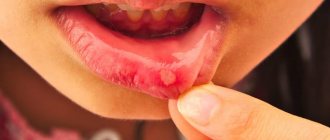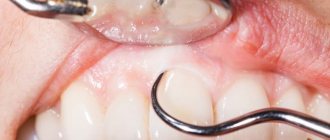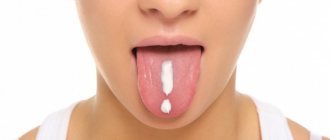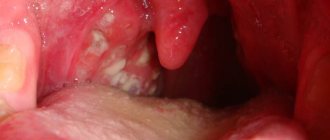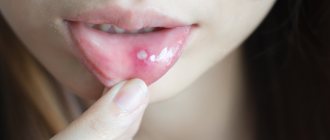Are you familiar with the feeling of burning and itching on your lips? Or the unexpected appearance of bubbles on the skin of the face and lips? 95% of the people on the planet know what I'm talking about. True, not everyone pays due attention to these things. Let's start with the fact that any inflammation of the oral mucosa is called STOMATITIS. But in this article we will talk about the most common disease in the world as a whole, popularly called HERPES. Namely, we will consider herpetic stomatitis, etiology, pathogenesis, clinic and treatment of this disease.
Causes
Herpetic stomatitis, or as it is also called aphthous stomatitis, is dangerous, first of all, for young children. It is a serious viral disease, which, in addition to damaging the oral mucosa, causes general intoxication of the body and provokes malfunctions of the nervous, immune, and reticuloendothelial systems.
Herpes, which is the causative agent of the disease, may not make itself felt for a long time, although infection usually occurs in early childhood.
When the baby’s immunity is weakened, the herpes virus is activated and begins to multiply, causing an increase in temperature, enlargement of the submandibular lymph nodes, acute inflammation of the mucous membrane, and the formation of bleeding and painful ulcers on its surface.
Main reasons:
- decreased baby's immunity;
- previous infectious diseases;
- lack of vitamins;
- insufficient oral hygiene;
- direct contact with patients with herpes stomatitis.
Infants are more likely to become infected with the herpes virus during childbirth, provided the mother has a herpes infection. In children under one year old and school-age children, the virus is activated against the background of an organism weakened by disease and vitamin deficiency.
Chronic aphthous stomatitis
Causes
Aphthous stomatitis is caused by staphylococcus, a microorganism that is found in large quantities in dental plaque and lives in carious cavities. Every person has this microbe and usually does not manifest itself in any way, but against the background of immune disorders. Often aphthous stomatitis can develop against the background of allergies, gastrointestinal diseases or injuries to the oral mucosa. Another factor in the development of the disease is dirty hands. This disease is often associated with children putting unwashed toys into their mouths, thereby increasing the total number and variety of microbes in the mouth.
Symptoms
Most often, manifestations of chronic aphthous stomatitis occur on the lips, transitional fold, gums, under the tongue and on the tongue - in places where the mucous membrane can be injured by teeth or spicy food.
- Minor change in general health. Characterized by enlargement of the submandibular lymph nodes, fever and weakness.
- On an externally unchanged mucosa, aphtha appears - a spot 5-10 mm in size, slightly rising above the surface of the mucosa, covered with a whitish film tightly fused to the mucosa and surrounded by a bright red rim. Aphthae are very painful when touched. Most often there are one or two aphthae, less often – several.
Must remember! It is necessary to accurately determine the type of stomatitis: herpetic or aphthous. With herpetic stomatitis, there are many small blisters that turn into erosions and sometimes merge with each other, and rashes on the lips are possible. With aphthous rashes, larger, single rashes occur only in the mouth. If you have stomatitis, you should definitely consult a dentist to determine the type of stomatitis and choose the right treatment tactics.
Treatment
Elimination of the factor that caused the disease:
- exclude all allergens (citrus fruits, chocolate, brightly colored foods...);
- if you are taking medications that can cause allergies, then you also need to take this into account (tell your doctor what you are taking and for how long);
- exclude rough, spicy, salty, sour foods;
- if stomatitis is caused by allergies, antihistamines (suprastin, loratadine) are prescribed;
- If the aphthae is due to injuries from sharp edges of a tooth or filling, it is necessary to put the tooth in order.
- in the first 3-4 days, treatment of aphthae is carried out exclusively with antiseptics (rinses, gels). You can use chlorhexidine, rotokan, miramistin, givalex, stomatidine, listerine, chamomile and calendula decoctions - you can take any of these drugs (or any other analogue). Use according to the instructions (there are preparations in ready-made form, and there are those that need to be diluted). Rinse (or wipe the mucous membrane in small children) 3-4 times a day.
- after 3-4 days, epithelializing agents are added: solutions of vitamins A and E, rosehip or sea buckthorn oil, solcoseryl.
- If relapses occur frequently, you should pay attention to your general health. In some cases, only joint treatment with an immunologist, gastroenterologist, endocrinologist and other specialized specialists can help cope with the disease.
Must remember! Aphthous stomatitis is, first of all, a microbial lesion. Oral hygiene, adherence to personal hygiene rules, as well as timely treatment of caries, caries complications, and removal of tartar in many cases are sufficient to avoid aphthous stomatitis.
Main symptoms and signs of the disease
Acute herpetic stomatitis in children develops gradually and is preceded by an incubation period lasting from two days to 3 weeks.
Early symptoms of the disease are:
- burning in the mouth;
- increased salivation;
- headache, nausea, general weakness;
- increased body temperature;
- enlargement of the submandibular lymph nodes;
- the appearance of bad breath.
«
If the parents do not respond to the first signs, after a few days the mucous membrane becomes covered with multiple rashes. Small painful blisters itch, respond with acute pain to the touch, and when they rupture, a cloudy liquid flows out of them. The rash appears on the baby’s gums, cheeks, tongue, lips, and wings of the nose.
Herpes stomatitis can affect not only a school-age child, but also an infant.
The mild form of the disease can be easily treated at home; in moderate and severe forms, hospitalization of the small patient is indicated.
Vincent's ulcerative necrotizing stomatitis
A severe form of stomatitis, which is caused by fusobacteria and spirochetes and, most often, begins against the background of decreased immunity due to ARVI, smoking, a general decrease in immunity and poor hygiene. Usually, seeing a picture of this stomatitis in a patient, doctors refer a blood test for HIV, blood sugar and STDs (this is due to the fact that this type of stomatitis occurs mainly in people with a very significant decrease in immunity, which, precisely, happens against the background of the above mentioned diseases).
Clinical picture of the disease
- At the first (initial) stage, general symptoms appear - weakness, headache, temperature 37.5 and above, dryness of the oral mucosa and bleeding gums at the slightest impact on them.
- At the second stage (the stage of the height of the disease), general symptoms intensify, the temperature can reach 40 degrees. Swelling and bright red coloration of the gums appears. The gums are sharply painful upon any touch, which is why the patient cannot perform hygiene procedures and eat food. At the slightest touch, the gums bleed. There is a putrid odor from the mouth and profuse salivation.
- Over time, erosions appear on the edematous mucosa in the area of the dental-gingival pockets and interdental papillae, which very quickly become covered with a grayish coating tightly fused to the base. Gradually, these erosions can spread further to the gums, cheeks, tongue, and palate.
- The third stage is recovery (with proper and timely treatment, the process is completely reversible). If treatment is not followed, then the disease may transition to a sluggish form with less pronounced symptoms.
Treatment
Treatment of this type of stomatitis should be carried out only by a dentist, otherwise there is a very high risk of the process becoming chronic and subsequent very rapid exposure of the roots of the teeth and loss of bone height.
- Under anesthesia, the doctor cleans out plaque and tartar, removes necrotic areas (enzymes are used for this), after which he carries out an antiseptic treatment and applies a therapeutic bandage.
- For home treatment, antibiotics, antiseptic rinses, applications of antiseptic and epithelizing drugs should be prescribed.
- The diet completely excludes all irritating foods (sour, salty, spicy, hard foods, alcohol, allergens), it is advisable to stop smoking.
- Symptomatic treatment involves correction of body temperature, as well as the use of local anesthetics as needed.
- Antihistamines (for up to 7 days) and vitamins are also prescribed.
Classification and diagnosis
Herpetic stomatitis is classified both according to the severity of the disease and the characteristics of its course.
According to the characteristics of the course, acute and chronic (recurrent) forms are distinguished. Acute stomatitis is characterized by a sudden onset, pronounced symptoms, and rapid development. Without proper treatment, it quickly becomes chronic and can drag on for years, periodically exacerbating.
Based on the degree of severity, there are mild, moderate, and severe forms.
In mild forms, the following are noted:
- slight increase in body temperature;
- redness, swelling, inflammation of the gums;
- swollen lymph nodes;
- a small number of painful ulcers.
The average degree is characterized by:
- significant increase in body temperature;
- general weakness, nausea, headache;
- inflammation of the oral mucosa;
- the appearance of a blistering rash on the inner surface of the cheeks, gums, tongue, and around the mouth.
The severe form causes:
- temperature rise to a critical level;
- lymphadenitis of the cervical, submandibular lymph nodes;
- a sharp disturbance in general well-being;
- the appearance of severe muscle pain, headache;
- nausea, vomiting;
- multiple rashes that spread to the eyelids, conjunctiva, and perioral area.
Diagnosing the disease is not difficult for an experienced doctor. It is based on an analysis of the main symptoms, the order of clinical manifestations of the disease, the nature, and multiplicity of ulcers.
It is necessary to differentiate herpetic stomatitis from viral stomatitis; for this, in the first few days of the disease, a cytological examination of scrapings from erosions and aphthae should be done.
CHRONIC RECURRENT HERPETIC STOMATITIS
Like acute herpetic stomatitis, chronic recurrent herpetic stomatitis goes through 4 stages of the disease and has three forms. The only difference is that the form of chronic recurrent herpetic stomatitis is determined not by the number of lesions (up to 5, up to 25 or more than 100), but by the frequency of occurrence per year.
The mild form of chronic recurrent herpetic stomatitis is characterized by the occurrence of lesions 1 – 2 times every 3 years;
The average form of chronic recurrent herpetic stomatitis is characterized by the occurrence of lesions 1 – 2 times a year;
The severe form of chronic recurrent herpetic stomatitis is characterized by the occurrence of lesions 4 or more times a year.
In chronic recurrent herpetic stomatitis, single or group elements of the lesion are detected, most often in the form of small blisters, which then appear, forming erosions. The mucous membrane is swollen and hyperemic. In severe cases of chronic recurrent herpetic stomatitis, a deterioration in the patient’s general well-being, headache, weakness, and body temperature of more than 39 degrees are added.
DIFFERENT DIAGNOSTICS OF HERPETHIC STOMATITIS
Differential diagnosis of herpetic stomatitis is carried out with chronic aphthous stomatitis, with exudative erythema multiforme, and with pemphigus vulgaris.
If we compare herpetic stomatitis and chronic aphthous stomatitis, then both lesions have aphthae. However, with aphthous stomatitis they are single, round, covered with a whitish coating and surrounded by a halo of hyperemia, there is no catarrhal gingivitis, the lymph nodes are not enlarged, and there is no elevated body temperature.
The differences between herpetic stomatitis and exudative erythema begin with the time of year. Most often, erythema occurs in autumn and spring and immediately begins to become difficult. That is, it is characterized by total damage to the mucous membrane, hyperemia, and edema. Erosions and ulcers are large, massive hemorrhagic crusts on the red border of the lips, cracks. The general condition also suffers: body temperature more than 40 degrees, weakness, malaise, multiple bluish spots (cockades) on the skin of the hands.
The difference with pemphigus vulgaris is that with pemphigus there are erosions that are slightly painful, located on the visually healthy mucous membrane of the oral cavity.
How long does the disease last and how many days is the child contagious?
Depending on the complexity of the form, herpes stomatitis in children lasts from several days to 2-3 weeks. With a mild form, the main symptoms disappear on the third or fourth day, treatment of a moderate form takes one to two weeks. The severe form is the most dangerous; healing lasts for weeks and requires mandatory hospitalization of the baby.
The disease is characterized by a high degree of contagiousness precisely during the period of exacerbation.
The infection is transmitted by airborne droplets (including through kissing), when using shared dishes, cutlery, toys, and hygiene items.
Herpes is contagious and can easily be transferred to healthy parts of your own body.
It is necessary to wash your hands thoroughly after treating the surface affected by the sores with medications to prevent the spread of the virus.
4. Treatment of stomatitis
Stomatitis is treated by dentists.
In general, mouth ulcers usually go away in no longer than two weeks, even without treatment. If the causes of the ulcer are established, the doctor will be able to choose the appropriate treatment. If they are not known, the main therapy will be aimed at alleviating the symptoms of the disease.
The following measures can help relieve pain and inflammation in the mouth:
- You should avoid hot drinks and foods, as well as salty, hot, spicy foods and citrus fruits;
- For severe pain, you can take painkillers;
- Rinsing your mouth with cool water or a small amount of ice can help relieve the burning sensation in your mouth.
To treat an ulcer, which is aimed at eliminating discomfort and protecting against infection, your doctor may recommend drinking more water and rinsing your mouth with salt water. Local anesthesia (such as lidocaine) may relieve pain. But this method for treating stomatitis in children is not recommended. A mixture of hydrogen peroxide and water in a 1:1 ratio or regular baking soda and water can be applied pointwise to the ulcer area. In addition, dentists may prescribe pain-relieving medications and corticosteroid pastes that can protect the affected areas on the lips and gums. Anti-inflammatory pastes, gels and rinses treat ulcers quite effectively and help reduce swelling and pain. They are also effective for severe cases of herpes on days 3-4, when the virus has disappeared but inflammation remains.
In any case, you should consult your doctor before taking medications, as some medications have side effects and are not recommended for people with diabetes and other diseases.
Treatment of herpes
There is no cure for herpes as such. We can only recommend lubricating the area of inflammation with special ointments (usually they contain acyclovir) and applying ice.
Sometimes doctors prescribe antiviral pills for herpes. Some experts believe that they can shorten the healing time of cold sores.
Stomatitis is usually not particularly dangerous, but not all ulcers are harmless. In any case, if stomatitis, inflammation and ulcers do not go away within two weeks, you should definitely consult a doctor.
How and with what to treat herpetic stomatitis in children
As Dr. Komarovsky notes, treatment of herpetic stomatitis in children, regardless of age, depends on the severity of the disease, the general condition of the patient’s immune system, and the presence or absence of concomitant diseases.
The main question that interests young parents is which doctor should they contact if they suspect herpetic stomatitis. Both a qualified pediatrician and a dentist can advise the child.
Therapeutic methods include both general and local treatment. Common activities include:
- prescription of antiviral drugs (acyclovir, Zovirax, Herpevir, Virolex);
- taking antipyretic and painkillers (paracetamol, Panadol, Eferalgan, Tylenol);
- prescription of antihistamines (diazolin, claritin, erius, fenistil);
- correction of the immune system (immudon, sodium nucleinate);
- vitamin therapy (vitamin C, ascorutin, multivitamins, B vitamins).
Children of older preschool and school age are recommended to be treated with broad-spectrum antibiotics to avoid possible complications.
For newborns and infants, antibiotic therapy is prescribed only as a last resort, with preference given to local therapy:
- applications of painkillers (solution of lidocaine, trimecaine, pyromecaine);
- treating the baby’s oral cavity with antiseptics (solutions of furatsilin, potassium permanganate, brilliant green, blue);
- Treatment of aphthae with iodine should be avoided, as it causes a burn to the mucous membrane;
- the use of antiviral medications in the form of ointments, lotions, solutions (interferon, acyclovir);
- applying an oil solution of vitamin A, sea buckthorn or rosehip oil, solcoseryl to the mucous membrane of the baby’s mouth).
If the symptoms of the disease do not disappear on the 3-4th day of treatment, but only intensify, the child is indicated for treatment in a hospital setting, otherwise stomatitis will become chronic, from which it is impossible to get rid of it.
Prosthetic stomatitis in an adult
From the name it is clear that this stomatitis is associated with dentures. It can be allergic and bacterial.
- Allergic stomatitis is the body’s reaction to the components of the prosthesis, namely the monomer of acrylic plastic. As a rule, this type of allergy appears due to the fault of the dental technician, when the proportions are not observed when mixing the plastic for the base of the prosthesis. If there is more monomer than needed, then it remains free in the finished prosthesis and then is released out, irritating the mucous membrane of the prosthetic bed. There are, of course, cases of real allergies, but they are rare.
- Bacterial stomatitis is the result of the action of bacteria adhering to the prosthesis on the mucous membrane. Together with humans, bacteria consume food and throw out toxic waste products. All these substances remain under the denture, and if the patient does not clean the denture or cleans it rarely or poorly, then he has every chance of “earning” such bacterial stomatitis.
Symptoms
Both variants of prosthetic stomatitis manifest themselves in the form of redness, swelling, and soreness of the mucous membrane clearly along the border of the edge of the prosthetic bed and do not affect the remaining mucous membranes.
Treatment
Treatment of prosthetic stomatitis depends on its form:
- If allergic stomatitis, then it is necessary to replace the denture (insist that the technician follow the instructions when mixing the plastic) or make a denture from a different material (for partial removable dentures there are now many options for base plastics).
- In the case of bacterial stomatitis, cleaning and polishing of the prosthesis is necessary (preferably in a laboratory), since by scraping off plaque at home, you can scratch the prosthesis, thereby creating additional places for microbes to conveniently settle.
Treatment with folk remedies at home
When treating herpes stomatitis in children, it is extremely important to prevent the development of complications and transition to a chronic form. Therefore, all folk remedies are auxiliary in nature and should not replace full treatment.
To strengthen the child's immunity, a decoction of echinacea leaves, ginseng root, and rose hips is well suited.
Rinsing will help relieve itching, burning and pain. For these purposes, you can use decoctions of chamomile flowers, sage, calendula inflorescences, St. John's wort, alder cones, rose petals, and oak bark.
The healing of ulcers and aphthae is facilitated by treating their surface with brilliant green, blue and iodine; they have a drying effect. An alcohol solution of propolis helps well, it relieves the inflammatory process and has an analgesic effect on the oral mucosa. Use with caution to treat small children.
Newborns and infants are recommended to lubricate the inflamed oral mucosa with natural honey. This should be done with extreme caution, since honey is a fairly strong allergen.
SYMPTOMS OF HERPETIC STOMATITIS
Knowing the symptoms of herpetic stomatitis is very helpful for timely treatment. That is, it is possible to prevent a vivid clinical picture.
Symptoms of herpetic stomatitis:
- Itching;
- Burning;
- Unpleasant sensation on the mucous membranes of the lips;
- There may be chills;
- Weakness;
- Malaise;
- Headache.
These, you know, are common symptoms that are precursors to the appearance of herpes. However, in the development of herpetic stomatitis there are 4 stages, each of which has its own symptoms.
STAGES OF DEVELOPMENT OF HERPETIC STOMATITIS
The first period or the first stage is the incubation period. This period is NOT clinically manifested.
The second stage of the development of the disease is the prodromal period (it is at this stage that the general symptoms of herpetic stomatitis are observed. Remember that symptoms may vary depending on the severity of the disease, it is written about it below)
The third stage is the period of development - also the period of rashes.
The fourth stage is the period of extinction - the mucous membrane and skin are restored, and the state of health also returns to normal.
CLASSIFICATION OF HERPETIC STOMATITIS
Classification of herpetic stomatitis includes:
- Acute herpetic stomatitis;
- Chronic recurrent herpetic stomatitis;
- Herpetic geometric glossitis;
- Gladiator herpes;
- Acute herpetic infection in newborns;
- Chronic herpetic infection with manifestation in the oral cavity in certain immunodeficiency conditions.
Herpetic stomatitis is also:
- Acute (occurred for the first time);
- Chronic.
ELEMENTS OF HERPETIC STOMATITIS
There is a certain order in which the elements of herpetic lesions appear on the red border of the lips.
First, a papule appears (a painless compaction in the form of a whitish nodule), then a bubble with contents appears (the contents can be transparent, it can be cloudy), after the bubble a crust appears, the crust has disappeared, and a spot appears in its place. And then everything is restored.
When the mucous membrane of the oral cavity is affected, there are some peculiarities. It all starts with a spot, which then turns into a vesicle (bubbles, as I said, can be either with transparent contents or with cloudy content), after the vesicle erosion occurs (hyperemic, painful, sensitive to irritants, an open area of the mucous membrane), which will turn into aphtha ( formation with a rim of redness along the edge of the element, whitish inside). And then again the stain and restoration.
Possible complications
Primary infection with herpetic stomatitis is highly treatable. Within 7-10 days, with proper treatment, the child can fully recover. Without appropriate drug therapy, the following complications may develop:
- herpetic keratoconjunctivitis (a dangerous herpetic eye infection that leads to blindness);
- dehydration (due to refusal to eat and drink).
To avoid undesirable consequences, it is necessary to consult a doctor at the first symptoms of the disease, strictly adhere to all instructions, give the baby plenty of fluids, monitor oral hygiene, and wash your hands after each treatment of a surface affected by herpes.
Content:
- The danger of herpetic stomatitis
- Causes of the disease
- Manifestation of herpetic stomatitis
- Diagnosis of the disease
- Treatment of herpetic stomatitis
The danger of herpetic stomatitis
Herpetic stomatitis is an inflammatory disease of the oral mucosa, which is caused by a well-known infectious agent - the herpes virus. Simple forms of inflammation cause discomfort, but do not threaten the patient. However, there are situations when the disease becomes severe: in addition to pronounced ulcerative-necrotic inflammation of the oral epithelium, the respiratory tract, vascular wall, and even internal organs can be involved in the process. You need to know the manifestations of this disease in order to consult a specialist in time, carry out treatment, prevent repeated episodes of herpetic stomatitis (since infection with the herpes virus is accompanied by its lifelong presence in the body) and prevent possible complications.
Causes of the disease
The etiological factor causing stomatitis in this case is herpes simplex virus type 1. There are also HSV - type 2, the so-called “genital herpes”. It is transmitted only sexually and causes damage to the mucous membranes of the genital organs; in this case, there is no herpetic lesion of the oral cavity. The mechanism of transmission of herpes simplex virus type 1 is carried out mainly by contact, much less often by aerosol. Infection occurs at an early age. The first episode of stomatitis is most often observed in childhood. This is primarily due to the fact that by the first year of life the child’s immune protection received from the mother weakens. Childhood is the main risk factor for developing the disease. In some cases, infection is not accompanied by any symptoms, and the child becomes a carrier of the virus. In this case, the disease can manifest itself at any age. For the development of the disease, predisposing factors are also necessary: a decrease in the body's defenses - hypothermia, stressful situations, hormonal disorders, exacerbation of chronic diseases. The herpes virus refers to microorganisms that have tropism (the ability to interact with certain tissues) for epithelium and nervous tissue. In this regard, the lesions will be localized on the mucous membranes and in the nerve formations of the body. Penetrating into cells, the virus begins to multiply and eventually spread throughout the body. Depending on the magnitude of the viral load, the disease will manifest itself at the time of infection or only after sufficient accumulation and reactivation.
Manifestation of herpetic stomatitis
Herpetic stomatitis as one of the forms of the disease occurs more often than others. The clinical picture is specific and allows, in most cases, to promptly recognize the disease and begin treatment. From the onset of symptoms to complete recovery, it can take from 3-5 days to several weeks. Most often, stomatitis begins with an increase in temperature to subfebrile levels. There may be mild symptoms of ARVI - redness of the mucous membrane of the nose, pharynx, tonsils. Lymph nodes can be involved in the process if the body overreacts to the introduction of the virus - most often this happens during the first episode of herpetic stomatitis. Lymph nodes in the head and neck area enlarge and become painful on palpation. The main morphological element of herpetic inflammation is the vesicle (vesicle). A vesicle appears on an inflamed reddish area of the mucous membrane of the lips, gums, cheeks or other area; it can be represented by a single element or multiple vesicles. During its development, the blister gradually increases (on average 2 mm, maybe up to 5 mm), bursts, and in its place an ulcer - aphthae - forms. Herpetic elements in the oral cavity and any other location are very painful. Sometimes there is severe salivation. In the case of moderate and severe cases, other organs are also involved, body temperature rises to 39-40 degrees, signs of intoxication are expressed - myalgia, arthralgia, nausea, vomiting, diarrhea, severe weakness. A lot of vesicles appear; after rupture, they turn into deep ulcers and become necrotic.
Diagnosis of the disease
If you suspect a herpetic lesion of the oral mucosa, you should consult a dentist. In some cases, a consultation with a general practitioner and a dermatovenerologist may be indicated.
Diagnosis is not difficult: collection of complaints and examination makes it possible to make a correct diagnosis at an early stage. In diagnostically unclear cases, methods of special diagnosis of the pathogen may be prescribed - it is detected in scrapings from the mucous membrane (virological diagnosis is difficult), an increase in the titer of antibodies in the blood (a more effective method), PCR diagnostics, and others.
Treatment of herpetic stomatitis
Treatment can be symptomatic - treatment of the oral cavity with solutions: hydrogen peroxide 3%, potassium permanganate 1:10000, furatsilin; it is possible to prescribe painkillers. Etiological treatment is prescribed when the diagnosis of herpes is confirmed. Specific antiviral drugs are used that act on the pathogen - Acyclovir, Valciclovir, Famciclovir. There are forms for local treatment in the form of ointments, as well as tablet and soluble preparations. In simple forms, antiviral drugs are applied only to the affected areas.
Prevention in children
Preventing infection with the herpes virus is extremely difficult, since 90% of the population are carriers of it. It is important to delay infection as much as possible; the younger the child, the more difficult the disease is to tolerate. It is necessary to avoid contact with people who have an acute herpes virus. From infancy, the baby should be taught to use personal hygiene products, not allowed to drink from someone else’s mug after someone else, or to use used spoons, forks, and plates. You should not kiss someone who has a herpetic sore on their lips.
To prevent herpetic stomatitis, you need to do general strengthening of the child’s immune system, systematically give him B vitamins, multivitamin complexes, and carry out hardening procedures.
Duration of the disease and contagiousness of the child
Herpetic stomatitis can last for several days or 2-3 weeks.
It all depends on the complexity of the form: with mild stomatitis, all symptoms disappear after 3-4 days; with moderate stomatitis, the disease lasts 1-2 weeks. The most dangerous severe form, treatment for which is delayed for weeks, and in this case the small patient must be hospitalized.
Stomatitis is characterized by high contagiousness precisely when it worsens. The route of transmission of infection in this case is airborne droplets and contact. You can become infected by sharing toys, dishes and cutlery, other people's hygiene items, as well as through kissing.
Herpes can easily be transferred to healthy parts of your own body. When treating surfaces affected by ulcers with medications, be sure to wash your hands well, this way you can prevent the spread of the virus.
